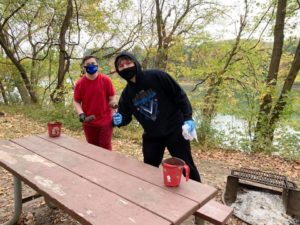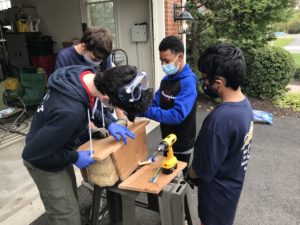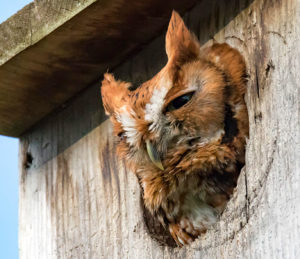For Jack R. of Troop 1094, Darnestown Elementary school brings up many fond memories for him as he attended it from kindergarten to fifth grade. Now being a bit older, Jack wanted to help out his former elementary school. He decided for his Eagle Scout Project that he could provide the school with a more beautiful front.
Unfortunately, after getting his project approved, the COVID-19 pandemic broke out. Yet being a good Scout, Jack adjusted his plans to fit safety guidelines, and he began his work in July. Jack and his volunteers started by getting rid of any stumps, weeds, and dead plants near the mulch beds in front of the school. He then trimmed the bushes and trees before planting some more bushes and grass. Jack then created a “DES” sign (Darnestown Elementary school), which was then placed at the front.
After completing this project, Jack felt satisfied with the results. He was also incredibly proud of how hard the work he and the volunteers put into helping Darnestown Elementary School.

 On the weekend of October 9-11, 2020 Troop 1550 camped at McCoys Ferry Campground (a National Park Campground) that’s located along the C & O Canal National Historical Park.
On the weekend of October 9-11, 2020 Troop 1550 camped at McCoys Ferry Campground (a National Park Campground) that’s located along the C & O Canal National Historical Park.
 Scouts from Ashburn’s Boy Troop 997 and Leesburg’s Girl Troop 998 joined together on a conservation mission for screech owls, organized by a Troop 997 Life Scout. The Scouts have spent the last week honing their woodworking skills building screech owl nesting boxes. The Eastern screech owl is not an endangered species, but its habitat is in decline, particularly in Virginia and the Northeast. Screech owls often resort to nesting in old woodpecker holes, but nesting boxes placed high in woodland trees keep the owls and owlets safe from predators like snakes, racoons and larger owls and other raptors.
Scouts from Ashburn’s Boy Troop 997 and Leesburg’s Girl Troop 998 joined together on a conservation mission for screech owls, organized by a Troop 997 Life Scout. The Scouts have spent the last week honing their woodworking skills building screech owl nesting boxes. The Eastern screech owl is not an endangered species, but its habitat is in decline, particularly in Virginia and the Northeast. Screech owls often resort to nesting in old woodpecker holes, but nesting boxes placed high in woodland trees keep the owls and owlets safe from predators like snakes, racoons and larger owls and other raptors. Eagle projects centering on building duck nesting tubes, bat boxes, duck feeders and bluebird boxes. Ian P. decided to focus on owls by building screech owl nesting boxes. He teamed up with Camp Highroad in Middleburg, a stellar United Methodist Church camp that has campsites frequently used by area Troops and Packs, as well as for leader training. Ian recruited Scouts from Troops 997 and 998G to build the nesting boxes, identified locations with the Highroads team, and will soon lead a team to mount them in likely nesting areas around the Camp. He built an extra nesting box and created a screech owl guide for the Camp’s nature education program. The guide includes information about the owls, the project, the installation locations around camp and instructions on annual maintenance.
Eagle projects centering on building duck nesting tubes, bat boxes, duck feeders and bluebird boxes. Ian P. decided to focus on owls by building screech owl nesting boxes. He teamed up with Camp Highroad in Middleburg, a stellar United Methodist Church camp that has campsites frequently used by area Troops and Packs, as well as for leader training. Ian recruited Scouts from Troops 997 and 998G to build the nesting boxes, identified locations with the Highroads team, and will soon lead a team to mount them in likely nesting areas around the Camp. He built an extra nesting box and created a screech owl guide for the Camp’s nature education program. The guide includes information about the owls, the project, the installation locations around camp and instructions on annual maintenance. Ian invited his sister Riley, a Star Scout and one of the founding members of Leesburg’s Scouts BSA Girl Troop 998, and her fellow Scouts to participate as well. They learned about the wildlife conservation and educational mission of the project, then received hands-on training with woodworking tools and methods. With over 80% of the Troop participating, the girls have taken what they’ve learned and accomplished, and completed the application material for the prestigious Hornaday Unit Award.
Ian invited his sister Riley, a Star Scout and one of the founding members of Leesburg’s Scouts BSA Girl Troop 998, and her fellow Scouts to participate as well. They learned about the wildlife conservation and educational mission of the project, then received hands-on training with woodworking tools and methods. With over 80% of the Troop participating, the girls have taken what they’ve learned and accomplished, and completed the application material for the prestigious Hornaday Unit Award.